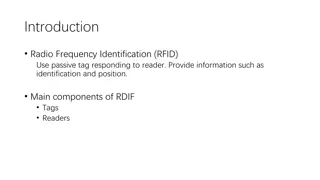EPC RFID Tag Security Weaknesses and Defenses: Passport Cards, Enhanced Driver's Licenses, and Beyond
Explore the vulnerabilities in EPC RFID tag security related to passport cards, enhanced driver's licenses (EDLs), and more. Learn about cloning risks, defensive strategies, and experimental evaluations of security measures for these identification documents.
Download Presentation

Please find below an Image/Link to download the presentation.
The content on the website is provided AS IS for your information and personal use only. It may not be sold, licensed, or shared on other websites without obtaining consent from the author. Download presentation by click this link. If you encounter any issues during the download, it is possible that the publisher has removed the file from their server.
E N D
Presentation Transcript
EPC RFID Tag Security Weaknesses and Defenses: Passport Cards, Enhanced Drivers Licenses, and Beyond Made Harta Dwijaksara Park, Yi Jae
Contents Introduction Experimental Evaluation of Passport Card and EDLs Defensive Directions: Backward Compatible Cloning Defense Co-opting KILL Co-opting ACCESS Advantage and Limitation Experiments with and Extensions to KILL-Based Authentication Conclusion 2
Introduction Explore the systemic risks and challenges created by the increasingly common use of EPC for security applications Implications of vulnerabilities to overall system security Suggestions for improvement Anti-cloning techniques for off-the-shelf EPC tags 3
Introduction EPC (Electronic Product Code) Tag Industry-standard RFID devices Supplant optical barcodes Identify each item manufactured Low cost and Relatively Long read range Class-1 Gen-2 tag EPC: Creation of Auto-ID Labs, currently managed by EPCglobal 4
Introduction Passport Card & EDL EPC tags are now seeing a landmark deployment in the U.S. in identity documents used at national border crossings Passport Card, EDL 5
Introduction Passport Card & EDL Passport Card Alternative to an ordinary U.S. passport booklet for land and sea travel within North America Cannot be used for international air travel Incorporate an EPC tag EDL (Enhanced Driver s Licenses) Regular driver s license + Passport card Authors use Washington State EDLs (WA EDLs) 6
Introduction Vulnerability Analysis Cloning The publicly readable data can be straight-forwardly cloned after a single read Tag Identifier (TID): tag-specific serial number Readability Other attacks EDLs are vulnerable to denial-of-service and covert-channel attacks 7
Experimental Evaluation of Passport Card and EDLs Weakness in the TID-based anti-cloning mechanism Other memory banks Kill-PIN selection Read-range experiments 8
Experimental Evaluation of Passport Card and EDLs Weakness in the TID-based anti-cloning mechanism The U.S. Department of Homeland Security think that TID can be used to remove the risk of cloning However, Gen-2 standard only requires TID identify the manufacturer and information about the tag s capabilities Authors have cloned a Passport Card and a WA EDL Also, tag-specific TID does not prevent the emulation of an EPC tag (logical copying) 9
Experimental Evaluation of Passport Card and EDLs Other memory banks The entire EPC memory bank which contains the card s unique EPC value is readable Kill-PIN selection Kill-PIN is unprogrammed and not locked on WA EDLs Can directly write 32-bit Kill-pin Can kill a cloned EDL 10
Experimental Evaluation of Passport Card and EDLs Read-range experiments Read ranges: a major determinant of the vulnerability of an EDL or Passport Card to clandestine cloning attacks and attacks against privacy Single scan of a tag is sufficient to create a clone Radio-opaque shielding sleeve uncertain that EDL and Passport Card bearers will consistently use their protective sleeves 11
Experimental Evaluation of Passport Card and EDLs Read-range experiments 12
Defensive Directions: Backward Compatible Cloning Defense Class-1 Gen-2 has no explicit anti-cloning feature Co-opting of two Gen-2 access control commands for authentication tag are proposed Co-opting KILL for tag authentication Co-opting ACCESS for tag authentication 13
Co-opting KILL (1/3) The KILL command is an EPC feature designed to protect consumer privacy by allowing tag to be disable at the point of sale in retail environments When the kill command received along with a tag- specific 32-bit KILL PIN Pkill, tag becomes permanently inoperative. This operation is a power intensive operation 14 Image source: Ari Juels, RFID Security and Privacy: A Research Survey . Journal of Selected Areas in Communication (J-SAC), 24(2):381-395, February 2006.
Co-opting KILL (2/3) A reader with knowledge of Pkill can authenticate a tag by constructing an invalid PIN P kill and transmitting the pair (Pkill ,P kill) in random order A valid tag will acknowledge the correct PIN and reject the incorrect PIN, an invalid one can respond correctly with the probability at most (KBA Kill Based Authentication) 15
Co-opting KILL (3/3) The challenge of KBA is the reliable transmission of command in the low-power regime of a target Too much power and the tag will be killed (permanently inoperative) Too little power, and the tag will not respond 16
Co-opting ACCESS (1/2) EPC tags can carry secret data D with read-access control Such data are readable only through use of the ACCESS command, with an accompanying tag-specific 32-bit PIN Paccess The Passport Card which analyzed here has both Pkilland Paccess set and locked But Washington State EDL could have its Pkill set and locked over the air (its Paccess is already set and locked) 17
Co-opting ACCESS (2/2) An entity with knowledge of Paccess for tag as well as D can authenticate the tag by checking D An entity without knowledge of Paccess cannot extract D without physically attacking the tag Known as ACCESS-based authentication (ABA) Challenge and Response Mechanism using ABA 18
Advantage and Limitation KBA is of interest for two reason ACCESS is optional command in EPC standard It is possible to deploy ABA and KBA independently KBA if not carefully implemented may actually kill the card as side-effect Neither technique is resistant to eavesdropping, cause they are ad hoc tools meant to allow authentication in the absence of cryptography or other supporting features The most compelling feature of KBA and ABA is their backward compatibility 19
Experiments with and Extensions to KILL-B ased Authentication Simple KILL-based authentication Reader ramps up the power until it receives response from a tag 15dBm to 30dBm in 0.25bB increments When reader successfully receives a replay from the target tag, the power level is fixed The reader then send N KILL commands, With N-1 bogus PINs, and 1 real PIN 20
Experiments with and Extensions to KILL-B ased Authentication Scaled KILL-based authentication 1. Determine the minimum reader power level PW RR to read target Determine the minimum reader power level PW RW to write target Verify PW RW - PW RR (minimum power-margin parameter) Scale the reader s power level PW RW + (PW RW - PW RR), [0,1] Ensure the power level selected doesn t allow a tag to write itself 2. 3. 4. 5. 21
Conclusion Class-1 Gen-2 tag can be cloned, need multiple security layer for supporting anti-counterfeiting not just using TID (authentication) In case of Passport Cards and Enhanced Driver license implication in the operational setting of border control are themselves some what more complicated Employing RFID technology in security sensitive environment needs government regulation to ensure the security 22





















